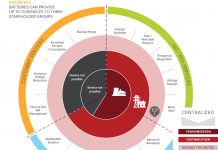John Petersen
The first quarter earning season is usually boring because it follows 45 days after year-end earnings reports and significant changes are the exception, rather than the rule. This year, the energy storage sector has been a clear exception and every company I track, other than the amazing gravity defying Tesla Motors, is down from its March 31st close. The following table summarizes the performance of the stocks I track from June 30th of last year and March 31st of this year through yesterday’s close.

While some of the declines can be attributed to transitory market volatility, others are more ominous. There are also some bright spots that point to significant opportunity. I’ll briefly summarize the developments I consider important below.
Ener1 (HEV) is a company that’s likely to face serious headwinds this year. In the first quarter they decided to write off their equity investment in Th!nk and booked $73.3 million in losses associated with the decision. As painful as these write-offs were, I believe we’ve only seen the first chapter. Th!nk is in the middle of a restructuring and Ener1 still carries $31 million of loans to and receivables from Th!nk on its balance sheet. Since restructurings are almost never kind to related party creditors, I believe a partial or full impairment of the remaining Th!nk accounts is likely later this year. I’m even more concerned about $10.7 million of intangible assets and $52.8 million of goodwill that arose from the accounting aether when Ener1 issued stock to buy a 19.5% interest in EnerDel and an 83% interest in Enertech. Intangible asset values of that magnitude are hard to justify in a profitable company. They’re almost impossible to justify in a development stage company. In a worst-case scenario Ener1 could see 70% of its book value obliterated by additional asset impairments.
Valence Technologies (VLNC) won’t report its year-end results till next week, but it looks like they may be losing an important customer to A123 Systems, which recently announced that it’s been selected to provide battery packs to Smith Electric Vehicles. It’s unclear whether A123 will get all of Smith’s future business or if the two companies will both supply batteries. Regardless of the outcome it can’t be good news for Valence which was hoping to finally break even after two decades of slow exsanguination. Since Valence is deeply under water from a balance sheet perspective, my outlook remains grim.
Altair Nanotechnologies (ALTI) has maintained a fairly stable market price on the strength of a pending investment from Canon Investment Holdings Limited. After yesterdays close, Altair announced that the closing date has been delayed yet again and that certain restrictions and penalty provisions in the original agreements have been modified or waived. While the outcome is far from certain, the short-term risks to Altair shareholders are not insignificant.
A123 Systems (AONE) is one of the bright spots for investors who believe that plug-in vehicles will become an important market force over the next few years. In late March it announced a public offering that provided about $254 million in new working capital. Roughly half of the financing came from sales of common stock at $6 per share and the balance came from subordinated debt that will be convertible at $7.20. On a fully diluted basis, the shares issued and issuable in connection with the public offering represent 27.5% of the company and imply a minimum market value of $6.32 per share. In the lithium-ion battery space, A123 strikes me as the only logical investment choice.
Axion Power (AXPW.OB) is a second bright spot that reported another quarter of solid execution. It confirmed that its second-generation automated electrode fabrication line has been installed and tested end-to-end, and is currently being tweaked to optimize dwell times. It also reported that a long awaited battery sale to Norfolk Southern was reduced to a purchase order. New disclosures confirmed that Axion has been working on HEV battery systems with a giant US automaker for the last year and that a pending DOE grant application names Axion as the prime contractor with the automaker, a research university and a national laboratory as named subcontractors. While a potential DOE grant in the $6 million range is not a company-maker, this is the first grant application I’ve heard of where an automaker agreed to share the marquee, much less share the marquee in a supporting role. My regular readers won’t be surprised by these developments, but a one of a kind DOE grant will, if awarded, almost certainly draw significant attention from market participants who’ve never heard my name and don’t know that Axion exists.
Exide Technologies (XIDE) won’t report its year-end results till June, but it’s a bright spot that has substantial short-term upside because it’s still suffering the lingering effects of a rough patch it went through in 2008 and 2009. Based on their most recent earnings reports, Johnson Controls (JCI) and Enersys (ENS) are both trading for roughly 16x earnings and 0.8x sales. Exide, in comparison, is trading a 9x earnings and 0.3x sales. As market confidence builds and the weighing machine assumes supremacy over the voting machine, I have to believe Exide’s stock price will gain 50% to 75% as it catches up with its peers.
The China Companies Group has been savaged over the last few months by the shamefully xenophobic logic that since some Chinese reverse merger companies behaved badly they must all be evil. They’ve been subjected to blistering attacks from acknowledged short sellers that take innuendo and conjecture to a whole new level. The problem, of course, is that writers like me can’t jump to their defense without an on the ground due diligence investigation. I expect the pressure to continue until saber rattling law firms complete their investigations and either find substantive problems or abandon the crusade. Once the air finally clears, I think many will view the current turmoil as the buying opportunity of the decade.
Tesla Motors (TSLA) continues to defy common sense and gravity as the poster child for irrational exuberance. Its book value at March 31st was $168 million and its market capitalization at yesterday’s close was $2.5 billion. In the most recent conference call management telegraphed plans to seek additional equity financing later this year. Last week I moderated an alternative energy panel discussion at a private meeting of money managers. The consensus was that Tesla would be able to raise additional capital, but not at a 15x premium to book. Investors in A123 were distressed when it conducted a public of
fering at a 25% discount to market that represented a 2x premium to book. I can’t even begin to imagine how the Tesla stockholders will respond when irrational expectations hit the brick wall of new investor valuation metrics.
In early March I created two hypothetical $25,000 portfolios. My long fuel efficiency portfolio included JCI, Enersys, Exide, Maxwell Technologies (MXWL) and Axion. Given the poor performance of the sector over the last month that long portfolio was down 9.3% at yesterday’s close. My short vehicle electrification portfolio included Tesla, A123, Ener1, Valence and Altair. It’s currently in the green by 31% and without the gravity defying performance of Tesla, my gains on the short portfolio would have been much higher.
Disclosure: Author is a former director of Axion Power International (AXPW.OB) and holds a substantial long position in its common stock.







